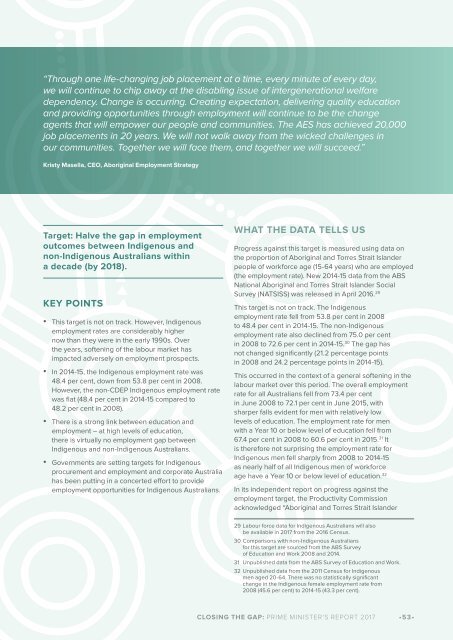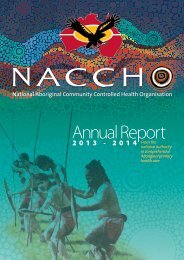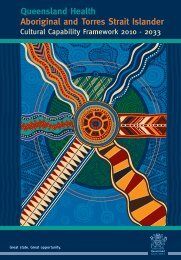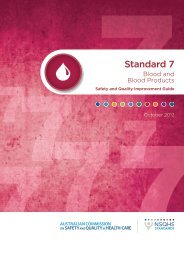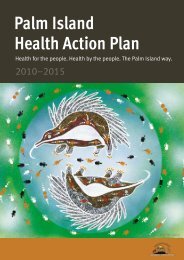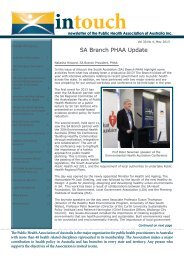CLOSING THE GAP
ctg-report-2017
ctg-report-2017
You also want an ePaper? Increase the reach of your titles
YUMPU automatically turns print PDFs into web optimized ePapers that Google loves.
“Through one life-changing job placement at a time, every minute of every day,<br />
we will continue to chip away at the disabling issue of intergenerational welfare<br />
dependency. Change is occurring. Creating expectation, delivering quality education<br />
and providing opportunities through employment will continue to be the change<br />
agents that will empower our people and communities. The AES has achieved 20,000<br />
job placements in 20 years. We will not walk away from the wicked challenges in<br />
our communities. Together we will face them, and together we will succeed.”<br />
Kristy Masella, CEO, Aboriginal Employment Strategy<br />
Target: Halve the gap in employment<br />
outcomes between Indigenous and<br />
non-Indigenous Australians within<br />
a decade (by 2018).<br />
KEY POINTS<br />
• This target is not on track. However, Indigenous<br />
employment rates are considerably higher<br />
now than they were in the early 1990s. Over<br />
the years, softening of the labour market has<br />
impacted adversely on employment prospects.<br />
• In 2014-15, the Indigenous employment rate was<br />
48.4 per cent, down from 53.8 per cent in 2008.<br />
However, the non-CDEP Indigenous employment rate<br />
was flat (48.4 per cent in 2014-15 compared to<br />
48.2 per cent in 2008).<br />
• There is a strong link between education and<br />
employment – at high levels of education,<br />
there is virtually no employment gap between<br />
Indigenous and non-Indigenous Australians.<br />
• Governments are setting targets for Indigenous<br />
procurement and employment and corporate Australia<br />
has been putting in a concerted effort to provide<br />
employment opportunities for Indigenous Australians.<br />
WHAT <strong>THE</strong> DATA TELLS US<br />
Progress against this target is measured using data on<br />
the proportion of Aboriginal and Torres Strait Islander<br />
people of workforce age (15-64 years) who are employed<br />
(the employment rate). New 2014-15 data from the ABS<br />
National Aboriginal and Torres Strait Islander Social<br />
Survey (NATSISS) was released in April 2016. 29<br />
This target is not on track. The Indigenous<br />
employment rate fell from 53.8 per cent in 2008<br />
to 48.4 per cent in 2014-15. The non-Indigenous<br />
employment rate also declined from 75.0 per cent<br />
in 2008 to 72.6 per cent in 2014-15. 30 The gap has<br />
not changed significantly (21.2 percentage points<br />
in 2008 and 24.2 percentage points in 2014-15).<br />
This occurred in the context of a general softening in the<br />
labour market over this period. The overall employment<br />
rate for all Australians fell from 73.4 per cent<br />
in June 2008 to 72.1 per cent in June 2015, with<br />
sharper falls evident for men with relatively low<br />
levels of education. The employment rate for men<br />
with a Year 10 or below level of education fell from<br />
67.4 per cent in 2008 to 60.6 per cent in 2015. 31 It<br />
is therefore not surprising the employment rate for<br />
Indigenous men fell sharply from 2008 to 2014-15<br />
as nearly half of all Indigenous men of workforce<br />
age have a Year 10 or below level of education. 32<br />
In its independent report on progress against the<br />
employment target, the Productivity Commission<br />
acknowledged “Aboriginal and Torres Strait Islander<br />
29 Labour force data for Indigenous Australians will also<br />
be available in 2017 from the 2016 Census.<br />
30 Comparisons with non-Indigenous Australians<br />
for this target are sourced from the ABS Survey<br />
of Education and Work 2008 and 2014.<br />
31 Unpublished data from the ABS Survey of Education and Work.<br />
32 Unpublished data from the 2011 Census for Indigenous<br />
men aged 20-64. There was no statistically significant<br />
change in the Indigenous female employment rate from<br />
2008 (45.6 per cent) to 2014-15 (43.3 per cent).<br />
<strong>CLOSING</strong> <strong>THE</strong> <strong>GAP</strong>: PRIME MINISTER'S REPORT 2017<br />
•53•


